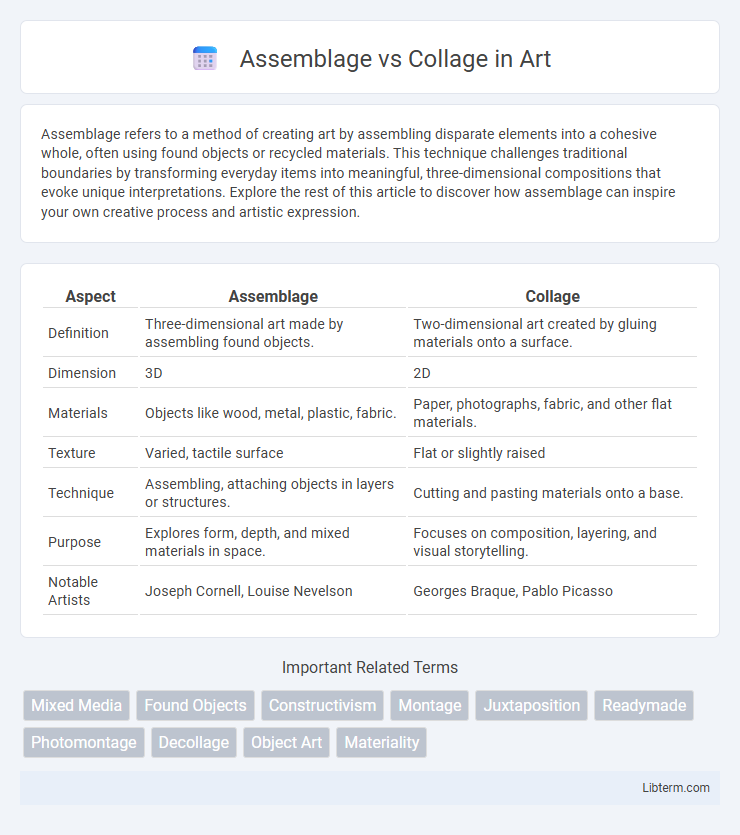Assemblage refers to a method of creating art by assembling disparate elements into a cohesive whole, often using found objects or recycled materials. This technique challenges traditional boundaries by transforming everyday items into meaningful, three-dimensional compositions that evoke unique interpretations. Explore the rest of this article to discover how assemblage can inspire your own creative process and artistic expression.
Table of Comparison
| Aspect | Assemblage | Collage |
|---|---|---|
| Definition | Three-dimensional art made by assembling found objects. | Two-dimensional art created by gluing materials onto a surface. |
| Dimension | 3D | 2D |
| Materials | Objects like wood, metal, plastic, fabric. | Paper, photographs, fabric, and other flat materials. |
| Texture | Varied, tactile surface | Flat or slightly raised |
| Technique | Assembling, attaching objects in layers or structures. | Cutting and pasting materials onto a base. |
| Purpose | Explores form, depth, and mixed materials in space. | Focuses on composition, layering, and visual storytelling. |
| Notable Artists | Joseph Cornell, Louise Nevelson | Georges Braque, Pablo Picasso |
Introduction to Assemblage and Collage
Assemblage and collage are both art techniques that involve the combination of different materials to create a unified composition. Assemblage uses three-dimensional objects such as wood, metal, and found items, allowing artists to build layered structures that emphasize texture and depth. Collage, primarily a two-dimensional medium, involves adhering paper, photographs, and fabric onto a flat surface to create visually engaging patterns and narratives.
Defining Assemblage: Key Characteristics
Assemblage is a three-dimensional artistic technique that involves creating a composition by assembling disparate objects and materials, often found or everyday items, into a unified work. Unlike collage, which primarily uses flat, two-dimensional materials such as paper or photographs, assemblage emphasizes texture, volume, and spatial relationships. Key characteristics of assemblage include its sculptural nature, the use of mixed media, and the transformation of ordinary objects into innovative, thought-provoking art pieces.
Understanding Collage: Core Elements
Collage involves assembling various materials such as paper, photographs, and fabric onto a flat surface to create a unified composition that emphasizes texture, color, and layering. Core elements include juxtaposition, where disparate objects or images are placed side by side to create new meanings, and the use of mixed media to enhance visual interest and depth. Understanding collage requires recognizing how these components interact to convey narratives or abstract concepts through visual storytelling.
Historical Origins of Assemblage
Assemblage, emerging in the early 20th century, originated as an innovative art form that assembles three-dimensional found objects into sculptural compositions, often linked to Dadaism and artists like Pablo Picasso and Marcel Duchamp. Unlike collage, which primarily involves combining paper and flat materials on a surface, assemblage incorporates diverse materials such as wood, metal, and everyday items, emphasizing texture and volume. This technique gained prominence with artists like Joseph Cornell and Louise Nevelson, who expanded its expressive and conceptual range during the mid-20th century.
Evolution of Collage Through Art Movements
The evolution of collage through art movements reflects a transition from early 20th-century Cubism, where artists like Pablo Picasso and Georges Braque pioneered integrating newspaper fragments into paintings, to Dadaism's embrace of found objects and absurd juxtapositions. Assemblage emerged in the mid-20th century, notably in the works of Robert Rauschenberg and Joseph Cornell, expanding collage into three-dimensional space by incorporating everyday objects and materials. This shift highlights collage's transformation from flat, paper-based compositions to immersive, sculptural art forms that challenge traditional boundaries.
Materials and Techniques: Assemblage vs Collage
Assemblage art involves creating three-dimensional compositions by assembling found objects, often combining wood, metal, fabric, and everyday items to build textured, sculptural works. Collage primarily uses two-dimensional materials such as paper, photographs, fabric, and printed media, which are cut, layered, and glued onto a flat surface to form a unified image. Techniques in assemblage emphasize spatial relationships and physical depth, while collage focuses on surface layering and visual juxtaposition.
Conceptual Differences: Meaning and Message
Assemblage emphasizes three-dimensionality by combining found objects into a cohesive sculpture, conveying complex narratives through spatial relationships and material textures. Collage, rooted in two-dimensional media, layers paper, photographs, or fabric to create new meanings by juxtaposing visual elements. The conceptual difference lies in assemblage's physical depth and multisensory experience, whereas collage focuses on surface interaction and visual metaphor to communicate ideas.
Iconic Artists in Assemblage and Collage
Assemblage features three-dimensional works by iconic artists like Joseph Cornell and Louise Nevelson, who crafted intricate sculptures from found objects and materials. Collage is exemplified by Pablo Picasso and Georges Braque, pioneers who fragmented and reassembled paper and images to challenge traditional perspectives. Both techniques revolutionized modern art by transforming everyday materials into complex visual narratives.
Assemblage and Collage in Contemporary Art
Assemblage and collage in contemporary art serve as dynamic methods for recontextualizing materials, where assemblage constructs three-dimensional artworks from diverse found objects, emphasizing physical space and texture. Collage focuses on two-dimensional compositions by layering paper, photographs, and other flat materials to create new visual narratives and fragmented realities. Artists such as Robert Rauschenberg and El Anatsui exemplify assemblage's integration of everyday objects, while contemporary collage continues evolving through mixed media digital techniques, expanding the boundaries of traditional art forms.
Choosing Between Assemblage and Collage
Choosing between assemblage and collage depends on the desired depth and dimensionality in art composition. Assemblage involves three-dimensional elements, offering tactile texture and spatial interaction through objects like wood, metal, or found items, while collage consists of two-dimensional materials such as paper, photographs, and fabric layers glued onto a flat surface. Artists seeking a more immersive and sculptural expression often prefer assemblage, whereas collage suits those aiming for layered visual narratives within a planar format.
Assemblage Infographic

 libterm.com
libterm.com